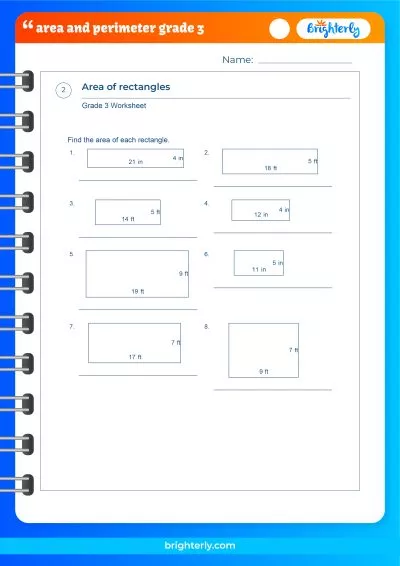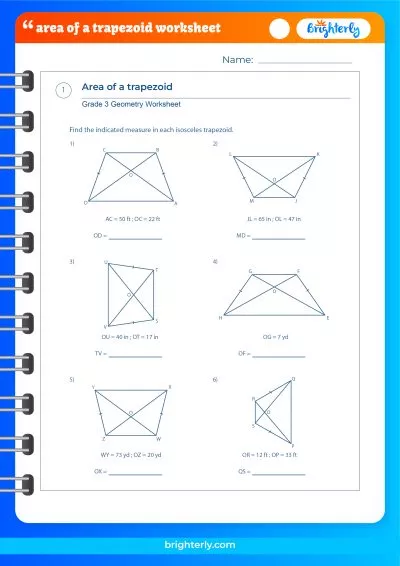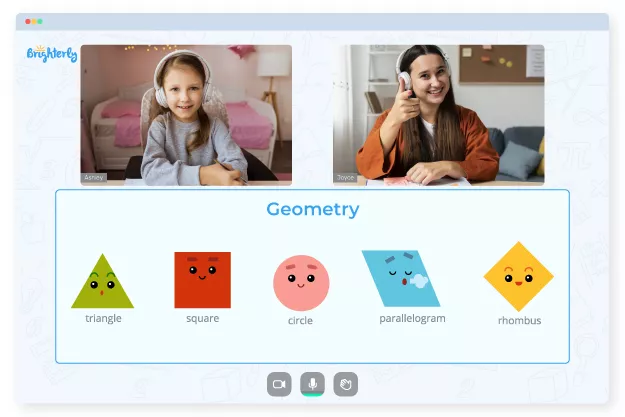Area in Math – Definition, Composite Figures, Examples
Updated on January 9, 2024
At Brighterly, we recognize that area is a key concept in mathematics that children must grasp early in their learning journey. By developing a strong foundation in understanding and calculating area, children can unlock the door to a world of more advanced mathematical concepts and applications.
Area, the measure of space within a two-dimensional (2-D) shape, is an essential topic that appears frequently in real-life situations, from determining the size of a room to calculating the amount of paint needed for a wall. As children learn about area through our Brighterly program, they will encounter various shapes, including rectangles, squares, triangles, circles, and polygons, and discover the formulas required to calculate the area of each.
What Is the Meaning of Area?
Area is a fundamental concept in mathematics and represents the total amount of space enclosed by a two-dimensional shape or figure. Area is measured in square units, such as square inches, square feet, square meters, or square miles, and is used to describe the size of flat surfaces like floors, walls, and fields. Understanding the concept of area is essential for kids because it helps them develop their spatial thinking, critical thinking, and problem-solving skills. Moreover, it has practical applications in everyday life, such as calculating the amount of paint needed to cover a wall, determining the size of a carpet, or designing a garden.
Area Formulas
Different shapes have different formulas to calculate their area. Here are some common formulas for finding the area of various shapes:
- Rectangle: Area = Length × Width
- Square: Area = Side × Side
- Triangle: Area = ½ × Base × Height
- Parallelogram: Area = Base × Height
- Trapezoid: Area = ½ × (Base₁ + Base₂) × Height
- Circle: Area = π × Radius²
Note: In these formulas, π (pi) is a mathematical constant, approximately equal to 3.14159. It represents the ratio of a circle’s circumference to its diameter.
How to Calculate Area?
To calculate the area of a shape, follow these steps:
-
Identify the shape: Determine which shape you’re working with (rectangle, square, triangle, etc.). Familiarize yourself with the different shapes and their properties, as this knowledge is crucial for selecting the correct formula.
-
Find the necessary dimensions: Measure or locate the required dimensions for the shape (e.g., length, width, base, height, radius). For irregular shapes or composite figures, break them down into simpler shapes and find the necessary dimensions for each.
-
Apply the appropriate formula: Use the corresponding area formula for the shape. Ensure that you understand how the formula works and the relationship between the dimensions, as this can help you avoid mistakes when performing calculations.
-
Calculate the area: Perform the necessary calculations to find the area of the shape. Don’t forget to double-check your work to ensure accuracy. It’s also important to include the correct units (square inches, square feet, etc.) in your final answer to convey the appropriate measurement.
-
Understand the concept: Practice calculating the area of various shapes to reinforce your understanding of the concept. This will help you develop your spatial thinking, critical thinking, and problem-solving skills, which are essential in various real-world applications.
More about Area
Area plays a crucial role in geometry, as it allows us to compare and analyze various shapes and figures. It also has applications in real-world scenarios, such as architecture, agriculture, urban planning, and interior design. In addition, area serves as a foundation for more advanced mathematical concepts, like volume (for three-dimensional shapes) and surface area (for solids).
Area is also a key component of other mathematical disciplines, such as calculus and probability. In calculus, for example, the concept of area under a curve is used to find the integral of a function, which has applications in physics and engineering. In probability, area can represent the likelihood of an event occurring, which is useful for making predictions and understanding uncertainties.
By exploring the various aspects and applications of area, you can gain a deeper appreciation for its importance in mathematics and the world around us.
Brighterly offers a wide variety of math worksheets to help children practice working with area.
Areas of Composite Figures
A composite figure is a shape formed by combining two or more basic shapes. To find the area of a composite figure, you can:
-
Divide the composite figure into simpler shapes: Break down the composite figure into smaller, more manageable shapes (e.g., rectangles, squares, triangles, etc.). This process may involve drawing lines, identifying shapes within the composite figure, or even cutting out paper shapes to visualize the breakdown.
-
Calculate the area of each simpler shape: Using the appropriate formula for each shape, find the area of all the smaller shapes that make up the composite figure.
-
Add or subtract the areas of the simpler shapes: Depending on the composition of the figure, you might need to add or subtract the areas of the simpler shapes to find the total area of the composite figure. Be mindful of any overlapping or empty spaces within the figure, as these may require adjustments to your calculations.
-
Apply the concept to real-world problems: Practice solving problems involving composite figures to develop your skills in applying the concept to various situations. This may include calculating the area of a garden with different sections, finding the amount of paint needed for a room with irregular shapes, or determining the size of a sports field.
Area of 2-D Shapes
Two-dimensional (2-D) shapes are flat shapes that have only length and width, but no depth. Examples of 2-D shapes include squares, rectangles, triangles, circles, and polygons. The area of a 2-D shape represents the amount of space it occupies on a flat surface. To calculate the area of a 2-D shape, use the corresponding area formula based on the shape’s properties.
-
Explore various 2-D shapes: Familiarize yourself with the properties and characteristics of different 2-D shapes, such as the number of sides, angles, and symmetry. This knowledge will help you identify the appropriate formula to use when calculating their area.
-
Understand the relationship between dimensions and area: Analyze how the dimensions of a shape, such as length, width, base, height, or radius, affect its area. This understanding will enable you to visualize how changing one dimension can impact the area of the shape.
-
Apply the formulas in different contexts: Practice using the area formulas for various 2-D shapes in different situations, such as calculating the area of a floor plan, designing a layout for a garden, or determining the size of a billboard. This will help you develop a better understanding of the practical applications of area in everyday life.
-
Solve problems involving irregular shapes: Learn how to calculate the area of irregular shapes by breaking them down into simpler shapes or using techniques like approximation and estimation. This skill is particularly useful in real-world situations where shapes may not always be perfect or easily recognizable.
-
Connect the concept of area to other mathematical concepts: Explore how the concept of area relates to other mathematical topics, such as perimeter, volume, surface area, and coordinate geometry. By understanding these connections, you can develop a more comprehensive understanding of mathematics and its applications.
By mastering the calculation of the area of 2-D shapes, you can enhance your spatial reasoning, problem-solving, and critical thinking skills, which are essential for success in various academic and professional fields.
Solved Examples On Area
Example 1: Find the area of a rectangle with a length of 12 units and a width of 5 units.
Solution: To find the area of a rectangle, use the formula: Area = Length × Width.
Area = 12 units × 5 units = 60 square units
Example 2: Calculate the area of a triangle with a base of 10 units and a height of 6 units.
Solution: To find the area of a triangle, use the formula: Area = ½ × Base × Height.
Area = ½ × 10 units × 6 units = 30 square units
Example 3: Determine the area of a circle with a radius of 7 units.
Solution: To find the area of a circle, use the formula: Area = π × Radius².
Area = π × (7 units)² = π × 49 square units ≈ 153.94 square units
Practice Problems On Area
- Find the area of a square with a side of 8 units.
- Calculate the area of a parallelogram with a base of 15 units and a height of 4 units.
- Determine the area of a trapezoid with bases of 9 units and 13 units, and a height of 5 units.
- Calculate the area of a composite figure formed by a rectangle and a semicircle (half a circle) with a radius of 6 units and a rectangle height of 10 units.
Conclusion
At Brighterly, we believe that understanding the concept of area is a fundamental skill for children. Area has practical applications in everyday life and serves as a foundation for more advanced mathematical concepts. By learning the formulas and methods for calculating the area of different shapes, kids can develop their spatial thinking, critical thinking, and problem-solving skills, which are essential for their success in various academic and professional fields.
Through engaging activities, interactive lessons, and real-world examples, Brighterly aims to help children explore the fascinating world of area in a fun and approachable way. We encourage kids to embrace the challenge of learning about area by breaking down complex problems into smaller, more manageable steps. This approach not only builds confidence but also fosters a deeper understanding of the underlying concepts.
As children progress through our Brighterly Math for Kids program, they will discover how the concept of area connects to other mathematical topics, such as perimeter, volume, surface area, and coordinate geometry. This holistic approach to learning ensures that kids develop a comprehensive understanding of mathematics and its applications.
In conclusion, the study of area offers children a unique opportunity to develop essential skills and gain valuable knowledge that will benefit them throughout their academic journey and beyond. At Brighterly, we are committed to nurturing a lifelong love for learning and empowering children to reach their full potential through the exciting world of mathematics.
Frequently Asked Questions On Area
Can the area of a shape be negative?
No, the area of a shape cannot be negative because it represents the amount of space enclosed by the shape, which is always a positive value.
How is area different from perimeter?
Area is the measure of the space enclosed by a shape, while perimeter is the measure of the total length of the sides or boundaries of the shape.
Is area always measured in square units?
Yes, area is always measured in square units to indicate that it represents a two-dimensional space.
Information Sources






